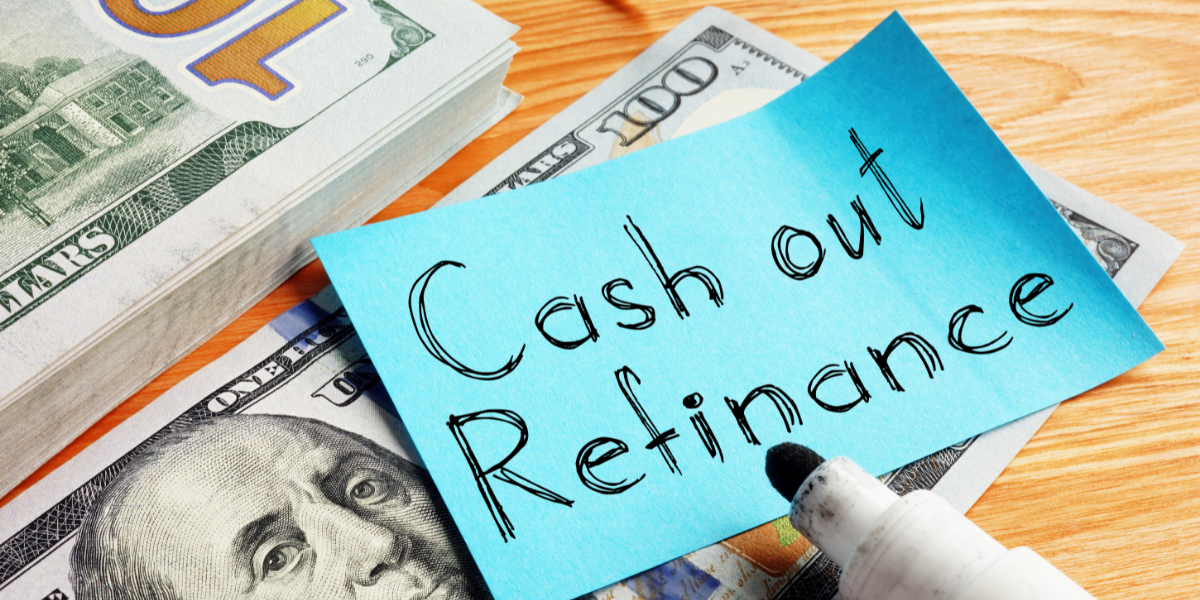Most people looking to lower monthly mortgage payments, reduce interest rates, or eliminate private mortgage insurance (PMI) often consider cash-out refinancing. However, a cash-out refinance can also be an effective method for real estate investments.
With more than a 15% increase in home values and mortgage rates at historic lows, it’s an excellent time for real estate investors to take the equity in rental properties and “cash out.”
In this article, we will discuss the basics of a cash-out refinance, how it works, and how to consider if it’s right for you.
What is a Cash-Out Refinance?
A cash-out refinance is a refinancing option that allows you to withdraw money from the equity in your home. This process pays off the original loan and replaces it with a new loan that has a new interest rate and term.
The new interest rate can be fixed or adjustable depending on the type of loan, a cash-out refinance. The loan terms and money you receive depends on elements like credit history, investment experience, and the appraised value of the home or property.
The portion of equity you choose to take out is added to your new mortgage principle. Refinance money can boost savings, consolidate debt, or make home improvements.
It’s important to note that you don’t instantly get the cash from refinancing. Once you decide to go through with a cash-out refinancing, you must have your home appraised, go through the underwriting process, and have the lender’s approval.
After closing on the new loan, you have three days to cancel the loan. If you do not cancel, you will receive the cash three to five days after closing.

Benefits of a Cash-Out Refinance Loan Program
What makes it an excellent option for real estate investors to consider?
When an investor pays off an existing mortgage using new loan terms, the cash difference is theirs to keep. This cash becomes a new source of capital to either make property improvements or purchase a new property.
Here are a few common reasons real estate investors choose a cash-out refinance.
Tax Benefits
One of the most significant advantages of cash-out refinancing for real estate investors is the tax deduction. The interest on a cash-out refinance is tax-deductible, as are most of the closing costs and others associated with the transaction. Unfortunately, investors often do not relish this benefit when borrowing money from banks or private lenders.
Favorable Loan Terms
Mortgage rates and terms are much better than interest rates from bank loans. Cash-out refinance loans have better interest rates than home equity loans. When directed toward real estate, this type of refinancing can save thousands. Additionally, there are fixed-rate and adjustable-rate options, making it easy for investors to find the best option for their situation.
Flexibility and Speed
With a cash-out refinance, the money can be used for various purposes. As a real estate investor, this means adding more capital. Additionally, cash-out refinances offer investors a quick start to accumulate the financial resources they need to make deals.
Although there are several benefits to a cash-out refinance, it’s essential that you know the rules. There are specific guidelines from Fannie Mae if you want to pull cash-out of rental properties.
- Properties can’t be for sale during the cash-out refinance process.
- Most properties purchased within a six month time frame are not eligible for cash-out refinance.
- Properties listed for sale within the previous six months must have a maximum loan-to-value (LTV) of 70%.
- Maximum 75% LTV for single-family homes or one-unit properties.
- Maximum 70% LTV for 2- to 4-unit properties such as a duplex or triplex.
- Adjustable-rate mortgages must have LTVs of 65% for one unit and 60% for 2 to 4-unit.

5 Steps for Real Estate Investors to Cash-Out Refinance
The process of cash-out refinancing for real estate investors is generally the same as it is for primary homeowners.
If you need a refresher, here’s a few common reasons why it’s difficult to get a loan.
However, real estate investors need to follow certain steps.
Step 1: Proper Documentation
Proof of Income: You may need to prove your income depending on the situation. If required, you’ll have to show the lender pay stubs from the last month. They may also want to see bank statements and other forms of income verification.
W-2 or 1099 Forms: These forms help lenders verify employment history and income. Self-employed people will need copies of a full tax return.
Homeowners Insurance: Proof of homeowners insurance is required to show that you have enough coverage on the property to protect the investment.
Title Insurance: This ensures the lender that the property or home in question is yours to refinance. It also gives a legal description of the home or property and tax information.
Asset Information: As an asset-based loan, a cash-out refinance means you’ll have to show copies of the borrower’s assets, things like investment accounts, retirement, savings, and bank statements.
Step 2: Apply
Although refinancing is typically less complicated than purchasing a home or property, you still have to go through the application and approval process. This process includes completing the lender’s application, submitting appropriate documents, and responding to all inquiries quickly.
Step 3: Lock in New Rates
Once your refinancing application is approved, you have the option to lock in your new interest rate. Before locking in your rate, take the time to read through the terms and consider all of your options. If you’re satisfied with the interest rate, you can lock it in. If you prefer to proceed with the loan and “float,” you can also do that.
Step 4: Underwriting
After locking in your new interest rate, you proceed with the underwriting process. During the underwriting process, a lender verifies the condition of a property and your documentation (income and assets). After verification, a home appraisal is ordered, which is an essential piece in determining a cash-out refinance.
An appraisal determines the fair market value of your home and shows your lender that the price you’ve agreed to pay for a home is appropriate. Appraisals are an effective way to estimate property taxes.
Step 5: Loan Closing
Once underwriting is complete and all documentation is approved, closing a new loan is the next step. Luckily, the closing process is much faster than traditional real estate closings.
You will receive a Closing Disclosure that details the new loan and all fees, including the closing costs. If all is correct, you will see the cash in your bank account within three to five days.
Cash-Out Refinance Loan Programs for Real Estate Investors
A cash-out refinance makes sense for investors, individuals, or businesses with considerable equity in their property. This large sum of money can be used for business expenses, funding repairs, purchasing more investments, and more.
A cash-out refinance is often not the right choice, especially on a rental property. For instance, if the property will be sold soon, a cash-out refinance may cost more than you receive. Also, depending on why you need to cash, a cash-out refinance may not be the best option if you don’t have an immediate use for the funds while still paying loan fees.
The benefits are top-notch when done for the right reasons. You can lock in low-interest rates, access maximum equity, and increase property values while generating more cash flow.
At Yieldi, we provide hard money loans to investors looking to cash out their equity quickly. For more information about cash-out refinancing or how to choose a loan program that’s right for you, our team can help!
Contact us online or give us a call! We’re more than happy to help!
